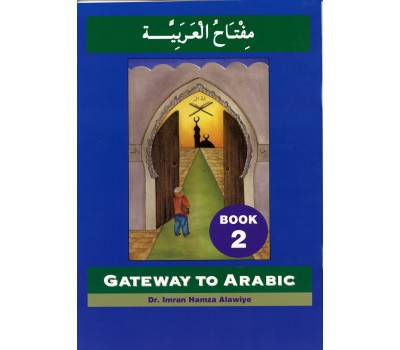Gateway to Arabic: Book 2
- Publisher: Anglo-Arabic Graphics Ltd
- Product Code: BK2192
- Availability: In Stock
- Book Binding: Paper Back
- Book Author: Dr Imran H. Alawiye
-
£5.50
Gateway to Arabic Book Two builds on the basic reading and writing skills acquired in Book One (Starter Book). With a vocabulary of over 350 words and easy-to-follow explanations, supported by 250 illustrations, Book Two provides learners with a basic knowledge of Arabic grammar, enabling them to take their first steps in understanding and using non-verbal sentences.
Gateway to Arabic Book Two marks the beginning of formal grammar and vocabulary learning and is suited to learners from the age of seven upwards. The book concentrates on non-verbal sentences and covers a wide range of useful, everyday vocabulary. Explanations of grammar points are kept to a minimum as far as possible at this stage, so as not to daunt younger learners. As with the rest of the ‘Gateway’ series, all Arabic text is fully vocalised throughout.
(Page 2) It begins with the question of gender, teaching students to recognise the taa marbuta feminine ending, using vocabulary based on items in the classroom and items found in the home. The first exercise engages the student in sorting vocabulary by gender, with scope for reading and handwriting practice.
(Page 4) Building on the initial vocabulary, students are taught to construct their first sentences using the ‘This is…’ (haadhaa, haadhihi) format in its masculine and feminine forms, thereby introducing the concept of the agreement of nouns with regard to gender.
(Page 6) The concept of gender agreement is then further reinforced through the introduction of adjectives, enabling the student to build up more complex sentences such as ‘This is a small house, and this is a big house.’
(Page 8) The interrogative particles ‘a’ and ‘hal’ and the words for yes and no are then taught, enabling the teacher to begin question and answer activities with the class. For example, ‘Is this a long ruler?’ (Hal hadhihi mistaratun taweelatun?), inviting the answer ‘No, this is a short ruler.” (Laa, hadhihi mistaratun qaseeratun).
The introduction of the word for ‘what?’ (maa?) and new vocabulary covering animals and shapes lends further scope for speaking, reading and writing practice, as does the teaching of the forms of ‘That is…’ (dhaalika nad tilka)
(Page 16) The knowledge of how to define words acquired in book one of the series is further reinforced and extended to cover subject and predicate sentences such as ‘This house is small’ (haadhal-baytu sagheerun) as opposed to the phrase ‘a small house’ (baytun sagheerun) with which the student is, by now, familiar.
Singular pronouns and a limited range of vocabulary relating to people, including some professions, are then covered, such as ‘he is a doctor’, ‘she is a teacher’ etc. This is followed by an introduction to the singular attached pronouns such as ‘This is my book’ (hadhaa kitaabee), ‘This is his sister’ (haadhihi ukhtuhu) etc.
(Page 21) The basic primary colours are then taught, using the animal vocabulary already acquired by way of illustrating the agreement of gender when using colours. Six further colours such as pink and brown are also taught in conjunction with some fruit and vegetable vocabulary for futher practice and usage.
(Page 25) Six key prepositions are then taught, with a brief outline of how they change the case ending of the following noun to a kasra. Vocabulary including the interrogative particle ‘Where?’ (ayna?) as well as items of clothing is used to explore the prepositions further by encouraging the student to describe where the items are in relation to other objects. This offers scope for reading and speaking practice, as well as classroom games.
(Page 29) A further interrogative particle, ‘Who?’ (man?) is then brought in to provide further scope for asking about people’s occupations.
(Page 33) Some passages of text follow providing opportunities for translation from Arabic into English and English into Arabic, as well as giving students the opportunity to write their own piece of descriptive text in Arabic.
(Page 35) Parts of the body are then taught, as a launchpad for introducing the concept of the dual in Arabic, which is taught in the nominative and accusative forms, together with the corresponding demonstrative pronouns and agreement of adjectives.
(Page 39) The various forms of the plural are then touched upon, beginning with the sound masculine plural, the sound feminine plural, and a brief introduction to the broken plural using nouns already covered so far in the book.
(Page 43) The use of plural demonstrative pronouns is outlined with an extensive exercise to reinforce this point of grammar. The last areas to be covered are the cardinal numbers from one to ten in the masculine and feminine forms, and some basic countries and nationalities giving students the chance to talk about where they are from and what nationality people are.
Gateway to Arabic Book Two is supported by an audio recording of the book on audio CD or cassette format, which is sold separately.
.jpg)
